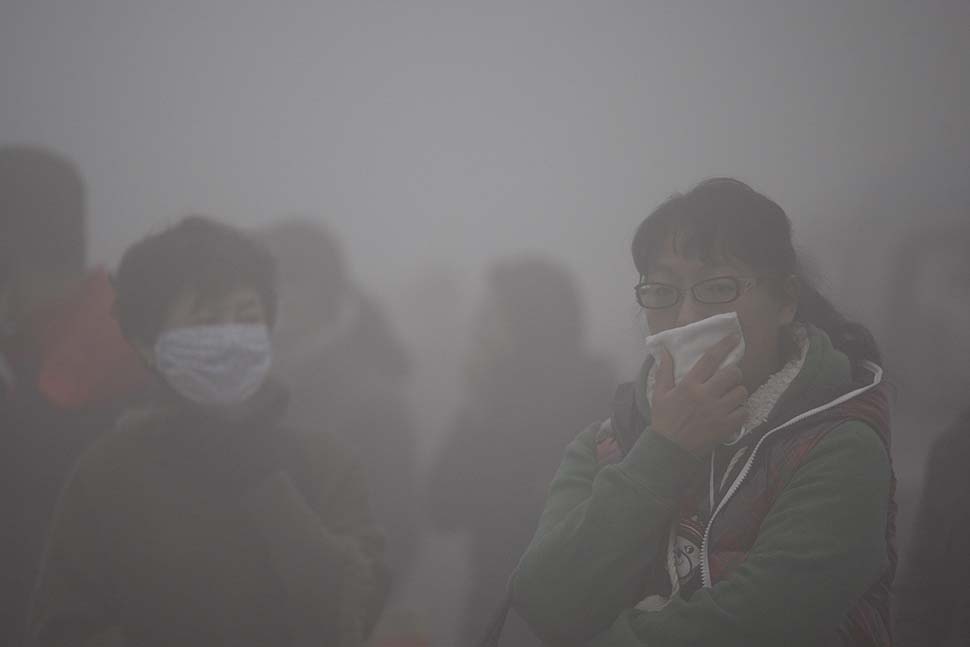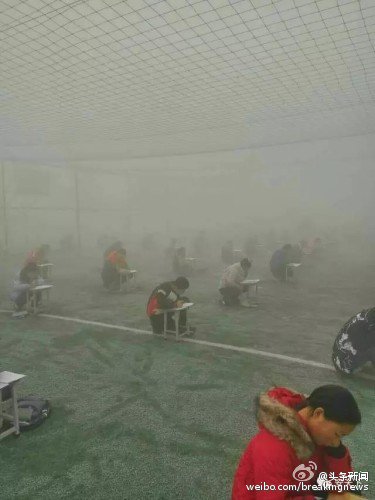The Pollution That Happens in Vegas Doesn’t Stay in Vegas

We start with the plight of Northern China, where the intensely thick and toxic exhaust from coal plants has forced the evacuation of more than 400 million people, about 5% of the entire world’s population. I’ve provided a few quotes from those afflicted and photographs that make the point. Like it or not, all that CO2 and methane, and all those oxides of nitrogen and sulfur, heavy metals and radioactive isotopes will soon be making their way around and through the entirety of the Earth’s atmosphere.
• “You just try to insulate yourself from the air as much as possible,” said Myllyvirta, a coal and air pollution expert.
• Jiang Aoshuang, one of Beijing’s “smog refugees”, told the state-run Global Times she had skipped town with her husband and 10-year-old son in order to spare their lungs. Jiang’s family made for Chongli, a smog-free ski resort about three hours north-west of the capital, only to find it packed with other fugitives seeking sanctuary from the pollution. “It really felt like a refugee camp,” she was quoted as saying.
• “You ask me why I left Beijing? It’s because I want to live,” Yang, 27, told the Guardian.
The second one lies in the same vein, though it contains some comic relief, as it illustrates our president-elect’s astonishing lack of understanding of basic science.
Think these next four years aren’t going to be catastrophic for our environment? Good luck with that.

Commuters cover their mouths while waiting for buses in the heavy fog and smog in Harbin, China on Monday.


@All Global Greenhouse Gas Emissions believers:
The bulk of the issues graphically depicted in this post, are caused by the accumulation of greenhouse gas emissions from reciprocating fuel oil engines and also coal/oil burning furnaces used in industry and the generation of electricity.
The ‘New Age Global Energy Imperative’ addresses this point concisely and is quite simply defined here:
A global inter-governmental policy and corporate technology development initiative to:
1. Replace fossil fuel energy generation technologies with new age enduring generation technologies that will deliver abundant, enduring, clean, safe, and low cost energy for network reticulated distribution for the use of all people, including developing nations and energy deprived regions (which will necessitate at least a four times (4) increase in current global energy generation capacity) and at the same time eliminate global energy generation greenhouse gas emissions to insignificant levels permanently. These new age energy generation technologies should commence global deployment by 1/1/2030.
2. Cease the manufacture and production of fuel oil engines globally by 1/1/2030.
3. Examine other (tier 2) industrial; commercial and agricultural activities that collectively make significant contributions to greenhouse gas emissions, and develop enduring new age technology solutions that will collectively within this broad sector, reduce these greenhouse gas emissions to insignificant levels permanently, with new age technologies solutions commencing global deployment by 1/1/2030.
Is this a daunting and oversimplified scenario?
No!
And on the contrary, all of these elements are definitely already forming up on the drawing boards of those decision makers who can and will be able to make this happen.
Lawrence Coomber
Craig,
I’m not sure what you want the President-elect to do about air pollution in the People Republic of China, but one thing is for sure, the Guardian article display’s either a profound lack of knowledge of the causes for Beijing’s air pollution, or is deliberately disingenuous.
It’s true the PRC’s heavy dependence on coal fired power is a major source of global pollution, and certainly a cause of concern for the entire world, not just China.
It’s equally true that the PRC government has only token regard for environmental concerns. Despite it’s environmental public announcements, PRC political leadership places more importance on industrial, military and economic priorities than environmental issues.
Seasonal air pollution in the capital has been a feature of the city for it’s entire 3000 year history.
Beijing’s air quality is affected by it’s proximity to the Gobi desert of Inner Mongolia. Fine dust and sand carried by winds from the northeast have traditionally plagued the city, although in recent years the frequency and severity of dust storms has decreased by the creation of artificial forests along the route of these storms.
While PRC authorities are quite happy to use these ancient storms to excuse modern pollution caused by excessive coal fired power generation, Beijing’s 12 million people are accustomed to the seasonal smog.
Normally, I’m not a defender of the PRC and it’s rulers, but the Guardian article inaccurately sensationalizes Beijing’s woes.
(I’m still not sure how sand from the Gobi desert can be attributed to Donald Trump).
Coal is the least profitable, and most pollutant of fossil fuel energy. Coal’s removal as a source of energy production is desirable, but not as easy as simplistic optimists and advocates imagine.
The coal industry suffers from a lot of erroneous disinformation and misconceptions. Power Grids as diverse as Germany and South Australia have learned the claims by supporters of Wind and Solar are often wildly distorted and irrational.
Just as it’s very difficult to disengage from oil, the only compatible substitution for coal is Natural Gas or Nuclear. The deployment of Renewable Sources can prove effective in supplementing coal-fired generation, but unfortunately the level of contribution by a renewable source also adversely affects the cost of coal generation, allowing renewable fuel advocates the opportunity to create distorted comparisons.
For major developed industrial economies, phasing out coal will be very difficult. The argument that it might be more environmentally beneficial to develop and deploy technology to minimize the harmful emissions, has some credence.
This attitude doesn’t display ” President-elect’s astonishing lack of understanding of basic science ” , but might offer an alternative to the close-minded advocates of renewable energy who seem to lack a basic understanding of economics and technology.
That’s the problem with taking an emotional/moralistic, rather than rational approach to energy generation.
The Guardian Newspaper has a very schizophrenic approach when it comes to the coal industry. Less than three decades ago, the UK government under Margaret Thatcher battled to rationalize the UK coal industry by effectively shutting down most of the industry.
During the four year, often very violent, battle with the powerful National Union of Miners, British trade union movement, Labour party, socialists, leftists, students and media such as the Guardian, the Thatcher government’s environmental arguments were dismissed as “the vicious lies of Tory propaganda” by the Guardian.
Even today, the same Guardian is supporting Chris Kitchen, general secretary of the National Union of Mineworkers claiming; “There is no economic case for the UK taxpayer to pay more to close pits than to keep them open. It’s just another case of a Tory government destroying the livelihoods of the British workers and their families ” ” The Guardian hailed the continuation of the unprofitable Daw Mill coal mine as ” helping to keep the lights on in the UK “.
The prolific Guardian journalist George Monbiot has an even more schizoid take on coal mining. As a dedicated supporter of the NUM, he extols the need to employ miners extracting coal, but condemns the use of coal !
All this confusion in the pages of the Guardian makes Donald Trump appear positively lucid and rational !
Coal still provides about 40% of the world’s electricity generation. That figure is being reduced as coal comes under pressure from vastly expanded natural gas production, and some renewable generation.
The problem for developing economies with access to natural gas, is the cheapness, reliability and ease of coal generation.
As Germany and Spain have discovered an over dependence on Wind and Solar creates a problem for the economics of generating base load power. Re-opening old coal power stations to run intermittently, isn’t economic and the much vaulted new grid technology doesn’t really work.
Regardless of the screams of unrealistic RFA utopians, coal fired power will continue to be used globally. Like the UK some older fields may prove uneconomic, but while there’s need and demand Coal production will continue.
The argument and reasoning behind accepting the continuation of a world coal industry for decades to come and investing in abating, minimizing, and mitigating the harmful pollution with better technology, may prove more environmentally beneficial, than a simplistic, irrational abolitionist approach.
Abolitionist crusades, are invariably divisive, emotional, simplistic and accomplish nothing lasting. These sort of crusades create massive disruption both socially and economically, yet invariably fail to produce any positive result.
It certainly isn’t easy or simplistic.
@Marcopolo
MarcoPolo’s views about the continued use of coal are correct, and rightly so because without coal the world would be without power (except for the minimum 1 % or there-about contribution of ad-hoc scattered solar PV and wind turbines).
There is no incompatibility at all however with global coal generation usage and at the same time, preparing the foundations and pathways to move away from global coal use, to be replaced by new age generation technologies.
Like everything orderly and successful hitherto – timing will be of the essence.
In fact regarding coal usage – just the opposite is required; we need to up our use of high quality energy generation coal in the short to medium term to fulfil global energy needs requirements. This is not at all incompatible with the end game scenario that must be worked towards in parallel.
I can’t agree with Marcopolo though who finds this a difficult to achieve global scenario. It doesn’t have any daunting elements attached at all in fact. It is a parallel and controlled international endeavour. Controlled environments and parallel pathways are rare circumstances in any field and these aspects are able to be fully exploited.
Nothing manufactured in the technologies development phase will become stranded or obsolescent in the medium term because of the research and development focus moving towards the “pointy end” of the limits in generation science, plus we have the luxury of a very reliable source of coal to keep the lights on whilst global deployment of replacement generation technologies gets started.
How manageable is all that.
I can visualize global deployment of replacement generation technologies starting 1/1/2030 and being effectively well advanced globally (where it needs to be first) by 2060.
This is much less daunting than one might initially think, and although I won’t be able to be a contributor to this new era like I was in the early renewable energy technology development days, because of my age; my 29 year old renewable energy engineer son Scott is looking forward to making a contribution to this new energy technology era about to unfold.
Lawrence Coomber
Hi Lawrence,
Thank you for your observations, and I don’t think our observations are incompatible.
You seem to be arguing for an ‘evolutionary’ process, not a disruptive ‘revolutionary’ process, this is my own position.
Happy New Year !
When I spoke about energy use in buildings at a workshop called Balancing Energy and the Environment at Lehigh University in 2007 one of the most interesting talks I heard was by a Lehigh Professor about the technology for cleaner coal burning which increases efficiency of combustion through computerized controls and reduces emissions. When I asked how common these technologies were he said uncommon because they add a significant cost to upgrade the power plant. A carbon tax would incentivize such upgrades. If China and India used the pollution controls on their coal power plants in use in this country (for now at least)it would help a lot.